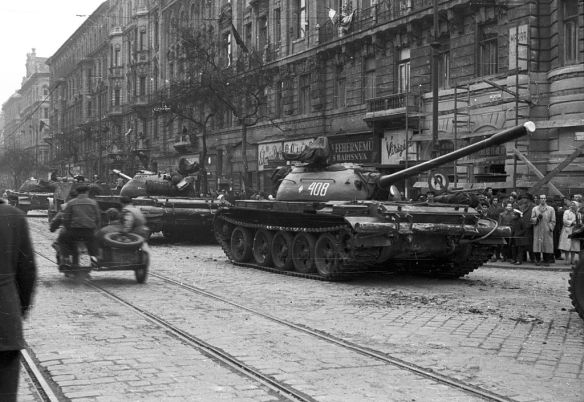Soviet T-54 tanks in Budapest on 31 October 1956.
Destroyed Soviet assault guns ISU-152 in Budapest 8th District.
A Soviet armored car burns on a street in Budapest in November 1956.
In Hungary the Soviet army was already in place, and its units went into action twice: at 2:00 a.m. on 24 October in Budapest, before retreating on 30 October; and on the night of 3-4 November. The worst of this fighting ended on 6 November, with a few pockets of resistance in the suburbs holding out until 14 November, as did the insurgents in the Mecsek Mountains. Confrontations with the army continued in December, linked to demonstrations in the streets. In Salgotarjan on 8 December, 131 people were killed in crossfire between Soviet and Hungarian units.
The Second Intervention
The establishment of a free, social-democratic Hungary upon the wreckage of a Communist dictatorship would have had the most profound consequences for world politics. Thus the temptation for the Kremlin to crush the Hungarians by force must have been truly powerful; still, one cannot utterly rule out a priori the possibility of a Soviet offer of compromise. But the Anglo-Franco-Israeli attack on Suez distracted and divided the West and encouraged the Soviets to seize the opportunity to reverse events in Hungary by sheer force. If London and Paris had dispatched their ultimatum to Egypt a month later than they actually did (October 30), it is certainly reasonable to imagine that events in Hungary might have taken a dramatically different course.
In any event, the fighting in Budapest and elsewhere made it perfectly clear that to reestablish control of Hungary would require far more than the two armored divisions that comprised the original Soviet intervention. Accordingly, on the night of October 29, new Soviet army units, including three thousand tanks, began entering Hungary. Many of the tanks in this second invasion were T-54s, less vulnerable to gasoline bombs. Now with eleven divisions, Soviet forces in Hungary sealed its western border, surrounded Budapest, occupied all strategic points outside the city, and encircled every airport. AVH men, sniffing their opportunity, guided Soviet tanks into Budapest. “The AVH were in their uniforms again, escorting Russian soldiers and picking out former insurgents for arrest.” Many of these Russian soldiers had actually believed that they were in Germany to fight the Nazis. Aircraft bombed the city, while on the ground the Soviets shelled and burned out many Budapest hospitals, killing or wounding physicians, nurses, and patients. As in Warsaw and Grozny, the insurgents used the sewers for communications. And in this second Soviet invasion, units of the Hungarian army offered resistance to the overwhelmingly powerful Russians. The puppet regime called on Hungarian soldiers to accept amnesty at designated areas; some took the offer, only to be mowed down by Russian troops.
As the fighting raged, representatives of the Nagy cabinet, including Pal Maleter, a Hungarian army colonel serving as minister of defense, were negotiating with the commanders of the Soviet forces in Hungary under a flag of truce. Against all international law, and against every concept of military honor and dignity, the Soviets seized the Hungarian negotiators and cast them into prison, nearly decapitating the revolutionary forces with this one shameful blow.
Casualties
Armed resistance in Budapest ended on November 14, although fighting continued in mountainous parts of Hungary for several more weeks. Budapest was in worse shape at the end of the second Soviet intervention than it had been in 1945 (when it was the wartime capital of an enemy state). In the country as a whole, at least 22,000 Hungarians had been killed (the proportional equivalent of 750,000 Americans) and many more thousands wounded. Several thousand Soviet soldiers were dead or wounded. Approximately 26,000 Hungarians were imprisoned, of whom 600 were later executed. Eight thousand officers were expelled from the Hungarian army. Over 200,000 Hungarians fled to Austria or Czechoslovakia before November 14. After that, “deportations began, as indiscriminate as 1945, trains full of people packed off at random to Russia.”
